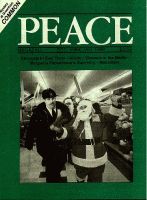
Peace Magazine Dec 1989-Jan 1990, page 24. Some rights reserved.
Search for other articles by Alan R. Drengson here
In modern societies, violence has become a major problem, damaging selves and communities. Damaged people harm the world. Violence spreads from self to community and world, and then back the other way. Is there a means by which we can correct ourselves and heal our relationships?
One would not expect to find the answer in a martial art, for the military arts are usually learned for purposes of intimidating, dominating, or even destroying "opponents." The warrior arts are based on winning and losing, not on peaceful cooperation. This very psychology of contest and domination is at the root of our most serious problems.
Aikido is a martial art which emphasizes many of the traditional values of the Warrior Way, such as self discipline, courage, and endurance. It also cultivates concentration and develops physical and spiritual strength. However, it stresses non-fighting. It teaches one not to oppose force with force, or to answer violence in kind. It inculcates respect for others and helps root out the sources of violence in one's own mind. It teaches harmony with a would-be opponent in physical movement and in spirit. Aikido creates no contestants, but friendships.
Founded in this century by Professor Morihei Uyeshiba (l883-l969), Aikido is often called the non-fighting martial art. There are partners, but no opponents. Instead, emphasis is on purifying one's own mind of the seeds of conflict, so as to cooperate with others. People come to understand one another through working together to perfect skills in the basic techniques. "Winning means winning over the mind of discord in yourself." (Uyeshiba) Practising the techniques together, we cooperate to create beautiful forms.
The word "Aikido" is composed of three Japanese characters which together mean, "the way of harmonizing with the universal energy (or spirit) of the universe." "Ai" means harmony and is also a homonym (in Japanese) of the word for love. "Ki" means universal, living energy or spirit. "Do" means the Way.
Professor Uyeshiba said,"Those who have a -mind of discord have been defeated from the beginning...There is no discord in love. There is no enemy in love." Although Uyeshiba was deeply influenced by Shinto teachings on nature and compassion, the philosophy of Aikido is close to the ethic of the Sermon on the Mount.
At an early age, Professor Uyeshiba was a prodigy in the traditional Japanese martial arts. As an adult he underwent a serious illness and a spiritual crisis, from which he gained insight into the deeper meanings of "budo," the Martial Way. Budo, as he saw it, should lead beyond the shallow conflict of wills or egos. "True budo knows no defeat. Never defeated means never fighting."
Fighting arises from the desire to defend or extend one's ego-self (nation-self) boundaries. To correct ourselves, so as to live purposefully and creatively in harmony with others and nature, is an important commitment. One source of correction is love. Mature love extends our sense of identification and concern. Uyeshiba said, "By love we purify ourselves...True budo is the loving protection of all beings with a spirit of reconciliation. Reconciliation means the completion of everyone's mission." When one acts as a centred being, one's actions naturally attract and harmonize with others, for one shows neither aggression nor fear. One contributes to others.
The secret of Aikido is to harmonize ourselves with the movement of the universe. Harmony can spread through our society as readily as discord, and it has far greater power for resolving our problems, which dominance and violence created in the first place.
Aikido is taught in a non-coercive way. Lessons learned on the practice mat carry over to daily life, for by harmonizing with whatever one is doing, one gives it one's fullest attention.
The physical techinques of Aikido fully embody its spiritual and philosophical orientation. The movements are spherical, flowing and spiral in form, practised in harmonious, complementary interactions with other persons. The warm-up stretching exercises (which are similar to some hatha yoga asanas) serve to increase flexibility, concentration and one's sense of stability. Aikido practice movements teach one to allow mind and body to settle into a natural state of relaxed balance and coordination. The use of practice weapons such as wooden swords, wooden knives, and staves, helps to emphasize the shape and timing of the various movements. The hand to hand techniques for throwing one's partner, or for evading aggressive thrusts and grabs, all illustrate the grace and natural power of Aikido as a martial art.
Aikido techniques optimize natural patterns and normal forms of flexibility. They do not "go against the grain." When one's Ki (the power that comes from the fully unified body and mind) is flowing, coordinated, and balanced, beautiful movement results. Although Aikido basic techinques are simple, they are rigorous and hard to master for their subtlety.
The design of new, nonviolent policies, institutions and technologies requires that the designers be reconciled with their communities and with nature, for then they will build into the designs and practices protection of self, others, and nature. This will be genuine defense of self, community, and nation. Such appropriate designers could be the vanguard of a new discipline, a Natural Guard, in the ecostery ("eco" as in ecology, and "stery" as in monastery) of the world, dedicated to nonviolently waging peace and protection. Ultimately, to protect the environment and humankind we must all follow a path of reconciliation. This is the gift of responsibility that will make us worthy of the power of our technology. Aikido is one discipline that helps us to grow into these responsibilities.
Drengson is a philosopher teaching at the University of Victoria.

Peace Magazine Dec 1989-Jan 1990, page 24. Some rights reserved.
Search for other articles by Alan R. Drengson here